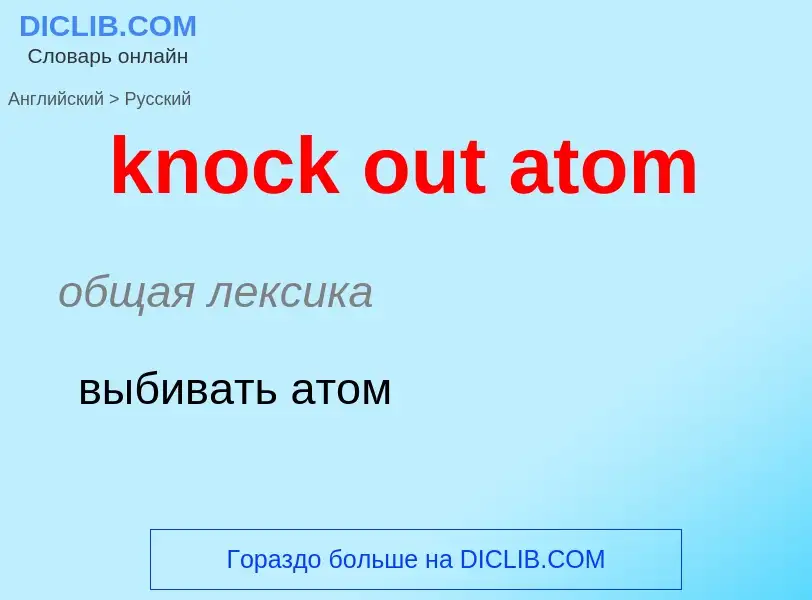Введите слово или словосочетание на любом языке 👆
Язык:
Перевод и анализ слов искусственным интеллектом ChatGPT
На этой странице Вы можете получить подробный анализ слова или словосочетания, произведенный с помощью лучшей на сегодняшний день технологии искусственного интеллекта:
- как употребляется слово
- частота употребления
- используется оно чаще в устной или письменной речи
- варианты перевода слова
- примеры употребления (несколько фраз с переводом)
- этимология
knock out atom - перевод на русский
COMICS
The Knockout Comic; The Knock-Out Comic; Knock-Out Comic
knock out atom
общая лексика
выбивать атом
atomic system
SMALLEST UNIT OF A CHEMICAL ELEMENT
Atoms; Atomic chemical; Atom and Atomic Theory; Atomic structure; Polyelectronic atoms; Bound-bound; Bound-bound transition; Structure of the atom; Multielectron atom; Ancient atom; Chemical atom; Chemical Atom; Number of atoms on Earth; Polyelectronic; Monoelectronic; Atomic system
математика
атомарная (неделимая) система
atomic structure
SMALLEST UNIT OF A CHEMICAL ELEMENT
Atoms; Atomic chemical; Atom and Atomic Theory; Atomic structure; Polyelectronic atoms; Bound-bound; Bound-bound transition; Structure of the atom; Multielectron atom; Ancient atom; Chemical atom; Chemical Atom; Number of atoms on Earth; Polyelectronic; Monoelectronic; Atomic system
строение атома
Определение
стек
СТЁК, стёкся, стекла, стеклась. прош. вр. от стечь
, стечься.
, стечься.
II. СТЕК [стэк], стека, ·муж. (·англ. stick) (спорт.). Твердый, эластичный хлыст, употр. при верховой езде.
Википедия
Knockout (UK comics)
Knockout may refer to one of two British comics. The original series, published by the Amalgamated Press (later Fleetway Publications), started on 4 March 1939 and ended on 16 February 1963, when it merged with Valiant. The second series, published by IPC Magazines, ran from 12 June 1971 to 23 June 1973, when it merged with Whizzer and Chips.


![hydrogen-like]] atomic orbitals showing probability density and phase ('''g''' orbitals and higher are not shown) hydrogen-like]] atomic orbitals showing probability density and phase ('''g''' orbitals and higher are not shown)](https://commons.wikimedia.org/wiki/Special:FilePath/Atomic-orbital-clouds spdf m0.png?width=200)

![Graphic illustrating the formation of a [[Bose–Einstein condensate]] Graphic illustrating the formation of a [[Bose–Einstein condensate]]](https://commons.wikimedia.org/wiki/Special:FilePath/Bose Einstein condensate.png?width=200)
![Atoms and molecules as depicted in [[John Dalton]]'s ''A New System of Chemical Philosophy'' vol. 1 (1808) Atoms and molecules as depicted in [[John Dalton]]'s ''A New System of Chemical Philosophy'' vol. 1 (1808)](https://commons.wikimedia.org/wiki/Special:FilePath/Daltons symbols.gif?width=200)
